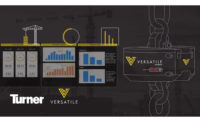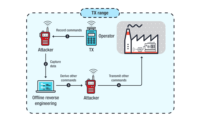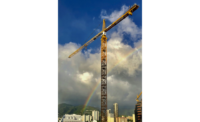Getting the most out of a tower crane is a key element in high-rise construction. Work doesn’t progress without the right picks to bring materials to height, and managing hook time is everything. After working though a recent pilot project, Turner Construction has found that a smart IoT crane-monitoring device from tech company Versatile is changing the way they run their cranes, with real benefits for productivity and weeks shaved off of construction schedules.
Designed to hang below the crane hook, the sensor-laden device has a camera that sees what's happening around the crane, and uses machine-learning algorithms to analyze the video and automatically identify everything hoisted by the crane. The system tracks every crane pick, and records it all in regular, detailed reports on crane utilization. In addition to visually identifying the objects beneath the hook, CraneView records the weight of the load as well as the cycle time, allowing for deeper analysis of how the crane is being used minute-to-minute.
Information is sent wirelessly to a cloud portal, where users can drill down and look for trends and indicators of where the crane is being underutilized. The videos of every lift can be reviewed as well, allowing lift planners and site superintendents to identify the factors that may be wasting time during a lift cycle.
Pilot Effort Shows Promise
The Manchester Pacific Gateway is a 17-story, 378,000-sq-ft, Class A office building that Turner is building for the U.S. Navy in San Diego. It will eventually house the headquarters for Navy Region Southwest as well as NAVFAC. Turner leadership had sought to deploy CraneView on the project relatively early in the process, but decided to wait until it was thoroughly reviewed by the company’s national safety director.
Once Turner was satisfied the CraneView could handle the rough conditions of the jobsite and not pose a safety hazard, it was deployed on the two tower cranes working on the San Diego office tower. By then, steel erection was already complete, and the next phase of the lifting and installation of the building’s precast panels was starting up.
“I felt through my career we never utilized cranes correctly, but gleaning the data to show that would take some real work,” says Steve Elliot, senior superintendent with Turner, who oversaw work at the Manchester Pacific Gateway project. “Within a week, [Craneview] was shooting us data and graphs and trends on where we were lagging on crane utilization. Paying attention to this we were able to shave 17 days off our panel erection schedule—just a massive gain, added a bunch of float to our overall schedule.”
Studying the reports, Elliot and his team were able to identify several unexpected causes of delays on site—brief delays that went unnoticed at the time but added up with dozens of repetitious crane picks.
After studying the footage and reviewing the data collected by CraneView, Elliot and his team were able to work with precast subcontractor Clark Pacific on a better way of staging the precast panels on the ground so the crane could begin the next lift cycle faster.
“We were able to see where the delays were and work with our subcontractor to bring those times down,” recalls Chris Brown, superintendent with Turner. “It was only an eight-minute duration on a pick, but keep doing that and by 300 picks it was really adding up.”
It turned out that neither the crane operator nor the riggers and ground crew were specifically at fault—it was just a logistical issue no one had considered. The precast panels arrived on trucks arranged for over-the-road transport, and had to be reoriented by the crane before riggers could prep them to be lifted up to the building.
This step only took a few minutes per lift, so the crane operator and riggers didn’t think much of it, but CraneView showed how doing this extra move on every precast panel was adding up over the week.
“It’s a few minutes for the crane to do this spin and grab it again; it’s a wasted move on an expensive crane,” says Brown. After meeting with the subcontractors and talking it over, a simple solution was found. “We brought over a heavy-duty forklift and used it to spin around the panels so when the crane came over there was no need to do a remedial spin.” Insights like that shaved a few minutes off every crane pick, eventually translating into over 24 work days saved in the overall project schedule, Brown says.
But while the team was always looking for these improvements to lift planning from studying the CraneView data, they didn’t expect some of the secondary benefits. “The obvious usage [of CraneView] is for critical path analysis: collect a bunch of data, see which precast panel takes the longest to lift,” says Holley Vela, project superintendent with Turner Construction. “But a lot of secondary data we got helped us with how we organized the site, like how we move our trash boxes around, and how we plan for deliveries to happen.”
Vela says it also gave the team insight into not only the performance of the crane’s operator, but the various subcontractors that were vying for crane hook time. “We could see how many panels we could let the precast guys hang before we should take them off the hook,” she explains. “The data showed there was a sweet spot of so many panels they could do before their productivity would drop off and it would start to take longer each time. At that point we can grab the hook and give it to someone else.”
But Elliot, Brown and Vela all agree that the data produced by CraneView is only useful if there is a good relationship with subcontractors to discuss possible solutions. “The idea of [CraneView] can be cool, but you really need to have somebody who will be engaged and move forward with the trade partners, so you are just not collecting data,” says Vela. “You have to have someone who collects the data and implements it, that can talk to the trade partners.”
The Manchester Pacific Gateway project had two hammerhead-style tower cranes, a Liebherr 630 and a Liebherr 420, both from Morrow. According to Elliot, the operators were not bothered by the CraneView, and largely forgot about it once it went on the hook. Subcontractors similarly didn’t object, once they realized it wasn’t there to spy on them but simply to record the lifts and prove how well they were doing their jobs.
“There’s no disputing what the device tells you. When it comes to crane usage by subcontractors, we had no arguments, since we had the photos and timestamps,” says Elliot. “We can say ‘here’s the data, it doesn’t lie.’ It’s a more fair and equitable way to manage the crane process.”
The Metronome of the Project
“What’s great about this solution is it brings a science to an activity that would otherwise be managed by rules of thumb,” says Jim Barrett, vice president and chief innovation officer at Turner Construction. “Almost every second you are feeding it data that can give you actionable insights.”
Barrett first began evaluating Versatile’s CraneViewer two years ago, and after much back and forth, including Turner’s intensive safety validation process, he was eager to get it on cranes on a real jobsite. “The crane is the metronome of the project, it sets the pace for the entire project life,” says Barrett. “If we get a better sense of what it is doing, it can transform the productivity of our projects.”
Barrett also sees CraneView fitting into Turner's broader philosophy on lean construction. “Lean is all about flow: do the materials and equipment get to the places they need to be when they need to be there," he says. CraneView gave Turner the metrics to evaluate where these wasted moves were happening, and Barrett says this data is driving better practices overall. “The overall job ends up being more effective. If the crane is slow, the job is slow.”
And while safety wasn’t the main reason Barrett sought out Versatile and CraneView, there were some benefits to that as well. “We saw fewer crane picks that were overweight, and worker behavior improved,” he says. With over 2,113 crane picks and 621 hours of operational time with CraneView installed, the project team reported zero under-the-hook safety incidents and zero near-misses. “It’s not meant to be a punitive measure, but if we can see whether people are standing properly around the load, rigging it properly, we have a way to start conversations about safety best practices now.”
With the crane work on the Manchester Pacific Gateway now complete, Barrett is hoping to deploy CraneView across other Turner projects where cranes will be up long enough to generate enough actionable data. He already has a handful of projects in mind. “Tower crane, crawler crane, it doesn’t matter. It’s all about projects with longer durations for cranes. I could see us as a company saying this is a general thing to use on every project like that,” he adds.
“As long as a crane has a meaningful role in the process we can work with them,” says Meirav Oren, CEO and co-founder of Versatile. “We won’t take on a project where the crane is on the edge of what is happening, we want to be where the crane is the pacemaker of the project."
Turner was one of Versatile's initial pilot partners, which has been running trials of CraneView with select firms. But the company has since opened up to working more broadly with interested contractors, and is offering 60-day trials of the device onsite. “We’ve had zero cancellations in the last 18 months,” adds Oren.
As Versatile scales up to serve more customers, Oren says the best part has been working with experienced industry professionals who were initially unsure if CraneView could improve their productivity. “Steve Elliot told me he was a skeptic at first; but he suspected they could be using the crane in a more productive way,” she says. “My own source of inspiration is proving those gut instincts to be right, and giving them data to have those discussions with their team. So many superintendents have said this [CraneView device] has finally proven them right—they have the data and can show that a decision was right or wrong, and then can see if solutions work or not.”
“It was a spectacular collaboration with Versatile,” says Elliot. “I learned in two short months what I had been wondering about for 20 years.”
[Turner Construction and Versatile released a case study on June 4th of the CraneView's performance on the Manchester Pacific Gateway project, which can be viewed here]








Post a comment to this article
Report Abusive Comment